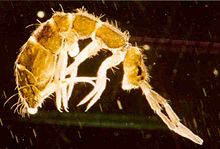Collembola
Description

Members of the Collembola Family are relatively small, typically less than 6 millimeters in length, with as many as six abdominal segments [1]. They have a tubular appendage called a collophore, which protrudes from the first abdominal segment. The collophore used to be thought to be a stabilizing mechanism for the collembola when it jumped by sticking to the surface on which it landed. More recent research has concluded that the collophore is used in osmoregulation, water intake, and excretion [2].
Collembola that live in the upper soil layers are often referred to as Springtails because of a tail-like appendage found among most species, called the furcula. It is a forked appendage attached to the fourth segment by a structure called the retinaculum and is used for jumping when the animal is threatened; it is not used for normal locomotion [3]. In as little as 18 milliseconds the furcula can be released from the retinaculum, snapping against the substrate and flinging the springtail into the air[4]. A reason that this mechanism is not used in typical locomotion is that it’s direction is very unpredictable. When the furcula is released, the springtail is sent tumbling through the air on an arbitrary trajectory, landing randomly [3].
Springtails are able to reduce their body size by up to 30% through genetically controlled molting if temperatures are high enough. Warmer conditions increase energy needs, as well as metabolic rates, therefore a smaller body size comes with many advantages to the organism [5].
Taxonomy
Kingdom- Animalia
Phylum- Arthropoda
Class- Entognatha
Subclass- Collembola
[6]
Habitat & Distribution

Collembola can be found in almost all regions of the world, from the coldest of and hottest places that can support multicellular organisms. Collembola can also be found from the highest of treetops to the deepest parts of soil that can sustain multicellular organisms[7]. Humidity plays a very important role in the distribution of collembola as they are susceptible to desiccation. Desiccation occurs when an organism is deprived from water and their bodies will start to shrivel and leads to the death of the organism. Collembola thrive in wetter environments due to this.
Evolution
Collembola are among the ancient arthropods as fossil records have dated them back all the way to the Devonian Era(400mya). Collembola have evolved throughout time to prevent desiccation. These adaptations include moving to high-humidity areas such as deep soils or under rocks. They also will limit activities during the day and do more of them at night to prevent excessive water loss if needed. Collembola also have made morphological adaptations to prevent water loss such as the development of scales and the thickening of the outer skin(cuticle)[7].
Environmental Impacts
Collembola have huge environmental impacts, mostly in forest ecosystems. There are two main ways that collembola support forest ecosystems. Soil organic matter dynamics and nutrient mineralization are the two main ways that collembola benefit these ecosystems[8]. Collembola effect the organic soil matter by quickly cycling nutrients that come from leaf litter and dead organic matter. The microfragmentation of plant detritus along with stimulating the activity of fungal and bacterial colonies positively impacts soils[8]. Collembola play an important role in nutrient mineralization which is taking the organic form of a nutrient and decomposing it into an inorganic form which then can be more easily accessed by other organisms keeping the soils fresh and high in biodiversity.
Collembola as Bioindicators
Collembola have been known to be great bioindicators. Bioindicators are powerful tools to evaluate the restoration of the environmental conditions in disturbed areas[9] Collembola are very sensitive to loss of their natural habitat owing to human interaction and thus represent useful indicators of tolerance to environmental stress[8]. In managed stands of forests(with human interaction) 51 species were found in and abundant 708,498 ind. m^-2( mean density) compared to semi- natural forests which had 36 different species in just 306,042 ind. m^-2[8].
References
[1]. Davies, W. Maldwyn (1927). "On the tracheal system of Collembola, with special reference to that of Sminthurus viridis, Lubb" (PDF). Quarterly Journal of Microscopical Science. 71 (281): 15–30.
[2]. Eisenbeis, G., 1982. Physiological absorption of liquid water by Collembola: absorption by the ventral tube at different salinities. Journal of Insect Physiology 28:11–20.
[3]. Christian, E., 1978. The jump of the springtails. Naturwissenschaften 65:495-496.
[4]. Piper, Ross (2007). Extraordinary animals: an encyclopedia of curious and unusual animals. Santa Barbara, California: Greenwood Press.
[5]. "The incredible shrinking springtail". Science. 341 (6149): 945. 30 August 2013. doi:10.1126/science.341.6149.945-a.
[6]. https://en.wikipedia.org/wiki/Springtail
[7] “Collembola.” Collembola - an Overview | ScienceDirect Topics, www.sciencedirect.com/topics/agricultural-and-biological-sciences/collembola.
[8] Nathalie Cassagne, Thierry Gauquelin, Marie-Claude Bal-Serin, Charles Gers, Endemic Collembola, privileged bioindicators of forest management, Pedobiologia,Volume 50, Issue 2,2006, Pages 127-134 https://doi.org/10.1016/j.pedobi.2005.10.002.
[9] Zeppelini, D., Bellini, B.C., Creão-Duarte, A.J. et al. Collembola as bioindicators of restoration in mined sand dunes of Northeastern Brazil. Biodivers Conserv 18, 1161–1170 (2009). https://doi.org/10.1007/s10531-008-9505-2
[10] “Springtail Culture Care: A Straightforward Guide for Breeding Folsomia Candida Springtails - On Feeding - Use Only Brewer's y...: Springtails, Vivarium, Reptile Room.” Pinterest, www.pinterest.com/pin/42784265190304769/.